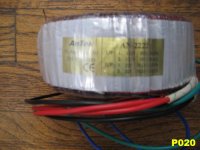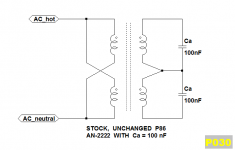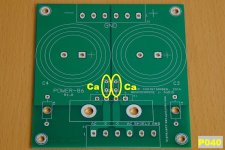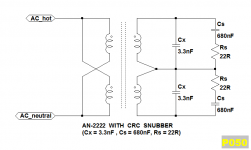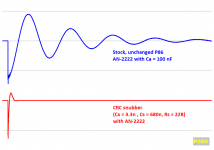I think Tom is the first here to achieve true success in understanding and laying out a PCB to make best use of a chipamp IC...................Other differences: The Modulus-86 will have about 40 dB higher CMRR, hence, reject EMI and noise much better than the TPA amp.
I don't see any measurements on the TPA amp either, so one is left to guess about the performance. The layout of the PCB matters tremendously at the performance level achieved by the Modulus-86. Without test gear, you'll be operating completely open loop for the PCB optimizations.................
To actually better the National distortion figures for the 3886 chip is quite an achievement.
I don't believe any other Member gets close to this chip performance.
Of course that's true but when all your recordings sound thinner than what you get on your reference system you can safely assume this is a characteristic introduced by the amp. I have noted this thinning characteristic in amps with more than four stages of signal processing (buffers included). The logical conclusion for me is an over-scrubbed signal that drops any combination of ambiance/dynamic/realism and I don't know if this can be effectively measured.fas42 said:...there are types of music which when reproduced correctly could be described as being "thin", that's just how the composer, player wanted it to sound for an effect...
Last edited:
I think you are wrong, to blame amp complexity.
I suspect an amplifier effect you are building in inadvertently.
I suspect an amplifier effect you are building in inadvertently.
I don't believe any other Member gets close to this chip performance.
I'm not sure that there is very much out there at all at this sort of performance level (within power constraints). Certainly (to steal monster munch strapline), pennies can't buy better specs. Bruno has done some really great stuff with hypex, but at a significantly different price point.
What is the time constant on the mute circuit? I assume it is fast enough to prevent thumps on and off when using Power86 supply?
I'll be connecting Mod86 direct to my tweeters, and looking forward to getting rid of the series xicon 22uF electros. 😀
I'll be connecting Mod86 direct to my tweeters, and looking forward to getting rid of the series xicon 22uF electros. 😀
In this case less than pennies has bought significantly better specs and significantly better performance............. pennies can't buy better specs...............
It costs nothing extra to run traces in the correct (least interference routing) location.
It costs nothing to run traces, however to know where to run them takes experience, lots of experience. which is not free.
One really has to acquire a taste for your replies. This statement seems to imply the number of signal processing stages has no influence on the sonic output character if all the other typical electrical attributes remain the same, is this what you meant? Apologies to Tom for the side dish here but it seemed like a direct challenge I needed to address.AndrewT said:I think you are wrong, to blame amp complexity.
I suspect an amplifier effect you are building in inadvertently.
Rather obvious when you think about it ... the ones made by your ear/brain as you "digest" the music - the problem is that test gear at the moment, no matter how expensive, doesn't mimic that analysis path.
The test gear we use isn't designed to mimic the way that the human brain processes music. It is designed to detect the kinds of distortions that electronic circuits introduce to music. Really think about that distinction. The brain is a stupendously complicated thing, music is a complicated language, but electronic circuits are simple, they can only screw up the sound in simple, stereotypical ways such as messing with the frequency response and adding nonlinear distortion.
This is a much easier and more effective way of working. You get a plot of some concrete parameter that relates to your circuit and suggests how to improve it, as opposed to your audio analyser shaking its head and saying that everything is grainy and veiled and the circuit "doesn't make any music".
Unless you believe you have discovered some new kind of distortion that is introduced by electronics, that you can hear but even Audio Precision don't know about. At least you will find plenty of company at the audio insane asylum. Oh wait, that's here. 😀
Last edited:
A few ADCs capable of 18+bits at 44.1+kHz do exist but I don't, offhand, know of any whose linearity and DNR/SNR exceed that of the Mod's
ES9102 is specced at -120dB THD+N... (and it is mostly "N" with very little "HD")
If anyone's interested in attaching a 3-element snubber to the secondary of their AN-2222 power transformer, I have some news. I connected an AN-2222 to the 3-element "Universal Modulus Toroid Snubber" described in post #408 , and got a well-damped, non-oscillatory waveform on the secondary. It's the red waveform.
Tomchr has designed a 1-capacitor, zero-resistor snubber into his Power86 power supply PCBoard; I tested that snubber too. As Tom mentions in post #406, the transformer secondary rings at an ultrasonic frequency with this configuration, and my testing agrees. It's the blue waveform.
If you prefer the blue waveform, the stock unmodified Power86 board provides it. If you prefer the red waveform, you'll need to add the Cs and Rs components. Total cost is about $2.50 for the additional parts, plus shipping.
_
Tomchr has designed a 1-capacitor, zero-resistor snubber into his Power86 power supply PCBoard; I tested that snubber too. As Tom mentions in post #406, the transformer secondary rings at an ultrasonic frequency with this configuration, and my testing agrees. It's the blue waveform.
If you prefer the blue waveform, the stock unmodified Power86 board provides it. If you prefer the red waveform, you'll need to add the Cs and Rs components. Total cost is about $2.50 for the additional parts, plus shipping.
_
Attachments
I think Tom is the first here to achieve true success in understanding and laying out a PCB to make best use of a chipamp IC.
To actually better the National distortion figures for the 3886 chip is quite an achievement.
I don't believe any other Member gets close to this chip performance.
Thank you for the recognition, Andrew. I really appreciate it.
You are absolutely right. Getting an LM3886 to perform to the specs listed in the data sheet requires a lot of care and feeding, in particular in the board layout. I demonstrated that quite clearly in the LM3886 P2P vs PCB thread.
With the Modulus-86, I improve many performance parameters by orders of magnitude over the performance of the LM3886.
~Tom
I think without knowing details that a non flat frequency response is much more likely to have a sound effect.One really has to acquire a taste for your replies. This statement seems to imply the number of signal processing stages has no influence on the sonic output character if all the other typical electrical attributes remain the same, is this what you meant? Apologies to Tom for the side dish here but it seemed like a direct challenge I needed to address.
That response error might not be seen in a constant and continuous sinewave test. It could be an error that shows up in more transient signals, that we generally don't test with.
If any of that were true, then it would be right to not blame amplifier complexity for the effect being heard.
I don't think that we can simply say complex circuits are why we hear differences.
Mod86 perfect for active speakers, bi-amping, etc ...
This is exactly where I was going with my gain questions:
http://www.diyaudio.com/forums/vend...er-achieving-0-0004-thd-n-48.html#post4159504
The Mod86 seems perfect for active speakers, bi-amping, etc ... 😎
One set of speaks I may try active, has a compression driver on a hf horn so it's very efficient. I might need a bigger spread than the THAT1200 20dB(10x) to the THAT1206 14dB(5x) . So ...
Would it be easier/sound better to increase the stock gain a bit: +20 dB (10x) to something like (15x)
or
Would it be easier/sound better to decrease the stock gain of the opamp/3886 a bit: +20 dB (10x) to something like (5x) [with the lowest gain THAT1206 ]
or
Would it be easier/sound better to decrease the stock gain of the THAT12xx to like (2x) and use the stock gain of the opamp/3886 ?
or some combo of these

Ok, I'm dizzy now!
Thanks and cheers,
Jeff
PS
Given that the woofer is high eff too, ideally I'd like to keep it's amp at the stock +20 dB (10x).
Given that the tweet is very high eff, ideally I'd like to keep it's amp as quiet as possible and really low (3x) or even no gain (1x) ... oh and keep the sound quality! 🙂 Possible?
...
My current project is 3way active speakers. I'm looking at your Modulus86 or the TP Sympatico for the amps. ...
What is the time constant on the mute circuit? I assume it is fast enough to prevent thumps on and off when using Power86 supply?
I'll be connecting Mod86 direct to my tweeters, and looking forward to getting rid of the series xicon 22uF electros. 😀
This is exactly where I was going with my gain questions:
http://www.diyaudio.com/forums/vend...er-achieving-0-0004-thd-n-48.html#post4159504
The Mod86 seems perfect for active speakers, bi-amping, etc ... 😎
One set of speaks I may try active, has a compression driver on a hf horn so it's very efficient. I might need a bigger spread than the THAT1200 20dB(10x) to the THAT1206 14dB(5x) . So ...
Would it be easier/sound better to increase the stock gain a bit: +20 dB (10x) to something like (15x)
or

Would it be easier/sound better to decrease the stock gain of the opamp/3886 a bit: +20 dB (10x) to something like (5x) [with the lowest gain THAT1206 ]
or

Would it be easier/sound better to decrease the stock gain of the THAT12xx to like (2x) and use the stock gain of the opamp/3886 ?
or some combo of these

Ok, I'm dizzy now!

Thanks and cheers,
Jeff
PS
Given that the woofer is high eff too, ideally I'd like to keep it's amp at the stock +20 dB (10x).
Given that the tweet is very high eff, ideally I'd like to keep it's amp as quiet as possible and really low (3x) or even no gain (1x) ... oh and keep the sound quality! 🙂 Possible?
Last edited:
I think you are wrong, to blame amp complexity.
I suspect an amplifier effect you are building in inadvertently.
I agree with Andrew. The notion that complex amp = complex sound = bad is misguided at best.
One really has to acquire a taste for your replies.
That may be true, however, starting a peeing contest over a particular communication style is not likely to make you many friends. Just saying... 😉
~Tom
What is the time constant on the mute circuit? I assume it is fast enough to prevent thumps on and off when using Power86 supply?
Actually, the mute time constant needs to be long/slow enough to prevent the thumps. And, yes, the time constant in the Modulus-86 mute circuit is long enough. The time constant works out to 3.3 seconds and the supply voltage needs to rise to about 2/3 of the final value before the amp starts to go out of the mute state.
~Tom
Well his last post is certainly a much more tempered admonishment than the one witnessed above it and kudos to AndewT on the newly added caveats but 'complex' was his word which also happens to be open to interpretation, I was very specific about forming a correlation with thin/sterile sound and circuit attributes. You will witness I stated all other conventional electrical attributes were unchanged and FR would seem to fall into that category of measurements. I also don't see why he decided to bring non-flat FR to this party when it clearly wasn't on the list. Do you maintain that increasing signal stages are unlikely to effect the sonic outcome negatively? AndrewT makes lots of valuable contributions and I respect him for that but he can be a bit of a bully when he thinks you don't know anything.
Last edited:
Would it be easier/sound better to increase the stock gain a bit: +20 dB (10x) to something like (15x)
Would it be easier/sound better to decrease the stock gain of the opamp/3886 a bit: +20 dB (10x) to something like (5x) [with the lowest gain THAT1206 ]
Would it be easier/sound better to decrease the stock gain of the THAT12xx to like (2x) and use the stock gain of the opamp/3886 ?
or some combo of these
For lowering the gain of the Modulus-86, I recommend using the lower gain flavors of the THAT1200-series. That's a plug-n-play solution. If you need an even lower gain than the THAT1206 provides, you will need to revisit the compensation of the feedback system(s) in the Modulus-86. That's a more complicated affair...
Increasing the gain of the Modulus-86 will result in lower loop gain available to provide error correction on the LM3886. A slight increase in the gain will result in a slight performance degradation.
~Tom
I, Andrew T., help a lot of newbies and other Members working in less familiar areas from their expertise...................AndrewT makes lots of valuable contributions and I respect him for that but he can be a bit of a bully when he thinks you don't know anything.
They don't get bullied.
When Members that claim to know but gradually after a number of posts reveal their true colours and as a result waste my time, then I may inadvertently get a bit (or a lot) shirty.
It's the few who won't listen that may get a repetition, or two. Maybe that is bullying.
I don't like it when some come to the table demanding all the answers and yet refuse to give any of their time over to researching their project.
Do your "homework" is one of my phrases, and it must ring true, for some, because I hear them complaining about my attitude.
Nope, same ol' boring ones that have been around for yonks - AP would certainly pick it up if the DUT was driven by the right test signal, but no-one has bothered to "invent" those beasties, as yet ... 😛Unless you believe you have discovered some new kind of distortion that is introduced by electronics, that you can hear but even Audio Precision don't know about. At least you will find plenty of company at the audio insane asylum. Oh wait, that's here. 😀
As a simple example, how susceptible is the DUT to RF interference of a certain type, level? Haven't seen a single measurement of that so far, it all falls into the category of "now, don't you worry your pretty little head about such things, Daddy's got it under control ... ", 😀.
- Home
- Vendor's Bazaar
- Modulus-86: Composite amplifier achieving <0.0004 % THD+N.

